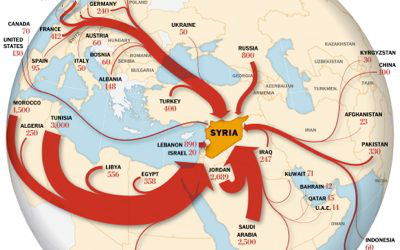How many jihadists are there in Syria and Iraq?
First published 5 Nov 2014 on Voltaire Net. See also Kobane: the object of all lies (4/11/14).
 |
The Syrian conflict, from the perspective of Australian history: In 1942, Australia, with the help of its American allies led by President Franklin Roosevelt, prevented invasion by the Empire of Japan. Much of this was due to the preparedness of Australia's own defence forces, as described in "Armed and Ready" (1995) by A. T. Ross. |
However, had Australia, in 1942, faced what Syria has had to face since March 2011 – hordes of foreign terrorists, estimated to number as many as 250,000, operating from countries bordering Syria – Australia almost certainly would have been conquered.
Against the expectations of even many sympathetic to Syria, she has withstood invasion and defeated the terrorists.
But that endurance has come at a terrible cost. Some estimates put the cost so far to be as high as 195,000 dead, in addition to the wounded and terrible material destruction suffered by Syria.
No country, not even a country as resourceful as Syria, can indefinitely defend itself from invasion from territories embracing at least one third of the world's land mass. Unless Syria's friends within those countries can force their governments to end their support for the terrorists, Syria could well be defeated. The consequences for Syria could well be commensurate with the carnage and destruction endured by its neighbour Iraq since 1990.
How many jihadists are there in Syria and Iraq?
Published 5 Nov 14 on Voltaire Net.
Since 18 July 2012, the beginning of the Nicaraguan-model war on Syria, fighters have flocked to the Levant from the entire Muslim world. According to the narrative spewed by the Atlanticist and Gulf media, it is all about spontaneous migration. The Guardian revealed that "A report by the UN security council finds that 15,000 people have travelled to Syria and Iraq to fight alongside the Islamic State (Isis) and similar extremist groups. They come from more than 80 countries." [ 1 ]
However, the Security Council does not itself draw up reports: it commissions them from the Secretary-General who, in turn, assigns the task to his representatives and committees. The newspaper did not reveal who authored the document in question. In all likelihood, the figures were provided by Peter Neumann, Director of the International Centre for the Study of Radicalisation at King's College London. This scholar, whose research unit is sponsored by the Interdisciplinary Center Herzliya (Israel) and who also serves as an expert for the George Soros Open Society Foundations, collected official figures from various sources except for those provided by two States directly concerned, Syria and Iraq. Neumann accompanied President Obama to the United Nations General Assembly and the Security Council meeting on terrorism, last September. In London, he is assisted by Aaron Y. Zelin (also an expert at WINEP, the AIPAC think tank). In other words, the Guardian falsely presents the numbers as originating from a neutral international entity when, in fact, they came from experts with US and Israeli ties.
|
Professor Neumann's figures coincide with those put out by the US intelligence services. They are on average 12 to 16 times lower than those provided by the Syrian Arab Army. As already seen after the attacks of September 11, 2001 when several institutes were given grants to produce analyses on the danger of Al Qaeda, today we are witnessing a proliferation of research studies on the jihad in the Levant, based on the same sources, so as to consolidate the Atlanticist and Gulf discourse. |
 |
Professor Neumann claims that the Islamic State attacked Iraq, conquered a large swath of Jordanian territory and administered it with only 800 men. Then, always according to him, IS considerably beefed up its troops and manages to keep the US Coalition in check with less than 5 000 men.
If such estimates are patently absurd, it is just as difficult to verify those provided by the Syrian Arab Army which, in June 2014, put the number of foreign jihadists who entered the country over the past two years at 250,000. However, an on-the-spot check renders this figure not only plausible, but even probable.
For example, at the beginning of the war, fighters from Libya arrived in two contingents. The first one was made up of Libyans affiliated with the Libyan Islamic Fighting Group (LIFG, Al-Qaeda in Libya). Their number was estimated to be at least 3 000, while Professor Neuman has only tallied 556 in three years. The second contingent consisted of 1 500 Afghans [ 2 ], while Professor Neumann found only 23 in three years.
The Syrian Arab Army says that it incinerates the corpses of the jihadists it eliminates, except where it has established repatriation agreements with the countries of origin. Thus, Damascus has quietly organized in conjunction with the Emir Abdelkader Foundation the repatriation of the remains of more than a thousand Algerian jihadists, while Professor Neumann's figure is only 250.
This controversy is not innocent: for the past three years, the Atlanticist and Gulf States narrative is that Syria is in the throes of a domestic revolution, supported by some foreign jihadists, while the Syrian Arab Republic claims to be the target of an attack from abroad by jihadists who arrived in droves, supported by some Syrians.
However, the outcome of the presidential election on 3 June 2014 showed that the Atlanticist and Gulf narrative was false, as Bashar al-Assad garnered 88.7% of the votes from his fellow citizens.
Footnotes
1. ↑ "Foreign jihadists flocking to Iraq and Syria on 'unprecedented scale' – UN", Spencer Ackerman, The Guardian, 30 October 2014.
2. ↑ "CIA recruits 1,500 from Mazar-e-Sharif to fight in Libya", Azhar Masood, The Nation (Pakistan), 31 August 2011.

Recent comments